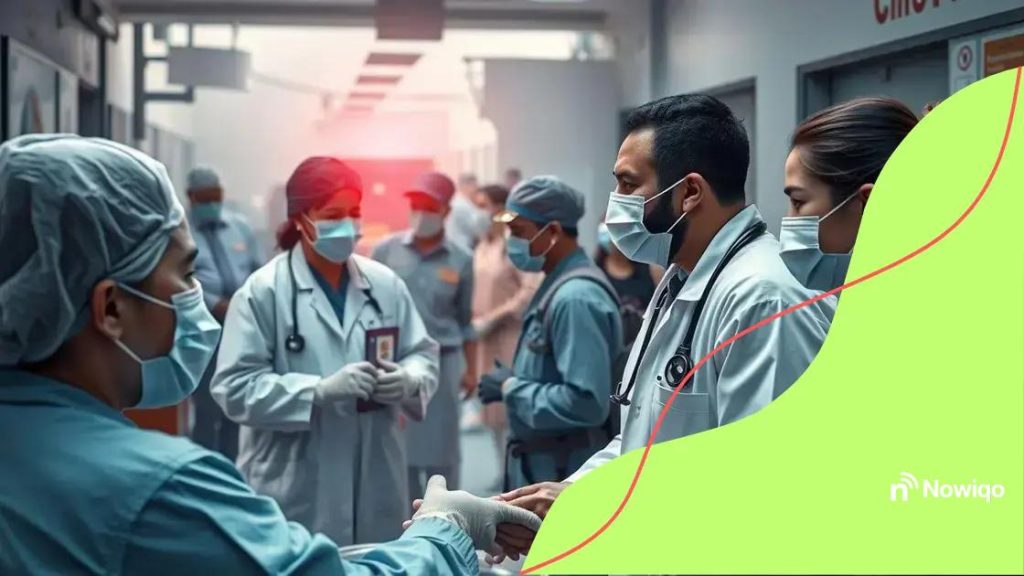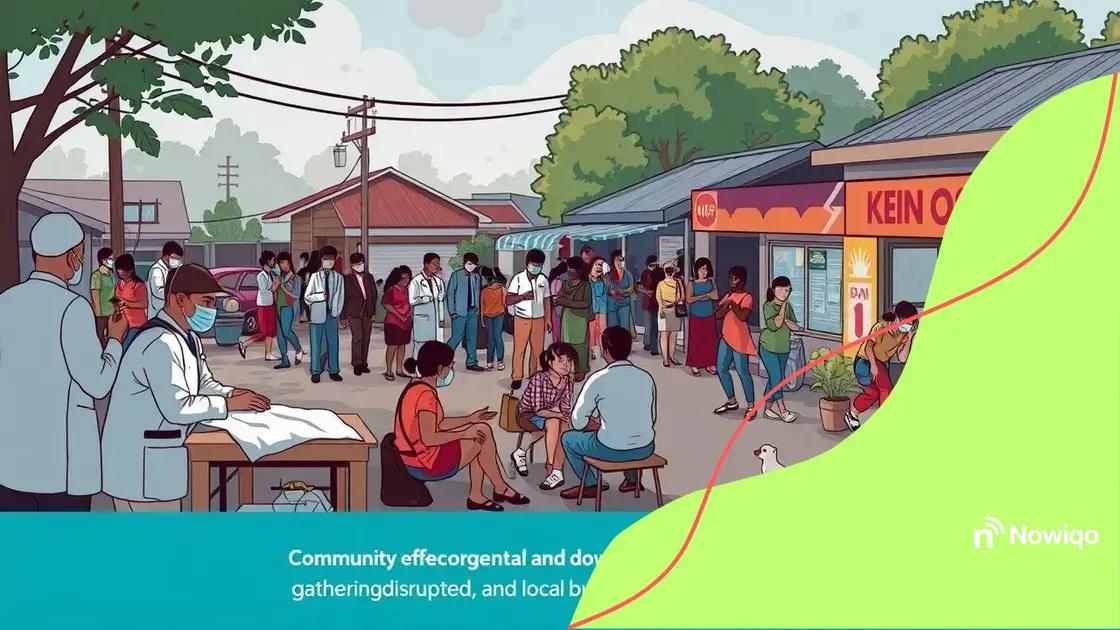Public health emergencies latest trends and insights

Anúncios
Public health emergencies involve significant health threats like disease outbreaks and natural disasters, necessitating preparedness through emergency plans, communication strategies, and community engagement to effectively manage and mitigate impacts.
Public health emergencies latest updates are essential for understanding the evolving landscape of health crises. Have you ever wondered how recent events shape our responses to public health challenges? Let’s dive in.
Anúncios
Understanding public health emergencies
Understanding public health emergencies is crucial for both individuals and communities. These situations affect the health and safety of populations, often requiring immediate action and collective response. Let’s explore what constitutes a public health emergency and why it matters.
Defining Public Health Emergencies
A public health emergency can arise from various sources, including natural disasters, infectious disease outbreaks, and bioterrorism. It’s essential to recognize these events early to mitigate their impact on society. Here are some types:
- Infectious disease outbreaks, like pandemics and outbreaks of flus.
- Natural disasters, such as hurricanes and earthquakes.
- Chemical or biological threats resulting from accidents or attacks.
Each type of emergency brings unique challenges that require a tailored response to protect public health.
Anúncios
Importance of Preparedness
Preparedness plays a vital role in effectively managing public health emergencies. Communities that engage in proactive planning are better equipped to handle crises. Key elements of preparedness include:
- Developing response plans.
- Training healthcare and emergency personnel.
- Educating the public on recognizing symptoms and safety measures.
By ensuring these elements are in place, communities can respond quickly and efficiently to emergent situations.
Public health emergencies often reveal weaknesses in health systems. During these times, it’s crucial to enhance collaboration among healthcare providers, government agencies, and community organizations. By working together, these entities can improve communication and coordination during actual emergencies.
Additionally, monitoring trends in health emergencies helps in anticipating and planning for future events. Using data effectively can lead to more robust response strategies, ultimately saving lives.
Recent examples of health crises
When examining recent examples of health crises, it is essential to recognize how these events shape our understanding of public health. These situations occur in various forms and can significantly impact communities around the world.
COVID-19 Pandemic
The global outbreak of COVID-19 stands out as one of the most significant health crises in recent history. This pandemic affected millions of lives and altered daily routines. Health organizations worldwide had to adapt quickly and effectively to the unfolding situation. The response to COVID-19 highlighted the importance of wearing masks, social distancing, and vaccination.
Here are some key impacts of the COVID-19 pandemic:
- Increased demand for healthcare services.
- Challenges in vaccine distribution.
- Economic repercussions affecting various sectors.
Ebola Outbreaks
Another critical example is the Ebola outbreaks in West Africa. Particularly notable was the outbreak that began in 2014, which posed significant health risks. Education and awareness were crucial for controlling its spread. Community engagement and prompt medical care were essential in managing the crisis.
The following factors contributed to the containment of Ebola:
- Rapid response teams were deployed to affected areas.
- Public health education to minimize transmission.
- Collaboration between governments and international organizations.
Analyzing these events helps improve our emergency response systems. By understanding what worked well and what didn’t, we can enhance our preparedness for future crises.
Furthermore, natural disasters like hurricanes have led to health crises due to their aftermath. Damage to healthcare facilities, along with the spread of diseases, underline the need for efficient disaster response.
Impact of emergencies on communities

The impact of emergencies on communities can be profound and long-lasting. Each crisis affects not only the health of individuals but also the social fabric and economy of the affected areas. Understanding these impacts is vital for future preparedness and response.
Health Effects
During health emergencies, the immediate effects on health services can be devastating. Access to medical care often becomes limited, leading to increased morbidity and mortality rates. Individuals may delay seeking care due to fear or lack of resources.
Some common health effects include:
- Increased cases of communicable diseases.
- Mental health issues, such as anxiety and depression.
- Challenges in managing chronic diseases due to disrupted care.
These issues underscore the importance of maintaining accessible health services during emergencies.
Social Disruption
During crises, communities often face significant social disruption. Schools may close, and community gatherings might be prohibited. This isolation can create a sense of uncertainty and fear among residents.
Additionally, vulnerability increases for marginalized groups who may lack the resources to cope with such disruptions. Social support networks can weaken, making recovery even harder.
Economic Consequences
The economic ramifications of emergencies can be severe and widespread. Businesses may shut down, leading to job loss and financial instability for many households. It can take years for economies to recover.
Key economic impacts include:
- Reduction in local business revenues.
- Increased unemployment rates.
- Strain on local services due to budget cuts.
To mitigate these effects, community resilience and preparedness initiatives are vital. These efforts help communities rebound quickly and effectively, ensuring that they remain robust in the face of future emergencies.
Preparedness strategies for individuals
Preparedness strategies for individuals are essential in equipping people to handle public health emergencies effectively. Being proactive can make a significant difference in how one responds to crises.
Creating a Personal Emergency Plan
One of the first steps is to create a personal emergency plan. This plan should outline steps to take during different types of emergencies. It helps individuals know what to do when faced with a crisis.
Key elements of a personal emergency plan include:
- Designating a meeting place for family and friends.
- Keeping a list of emergency contacts.
- Establishing communication methods if separated.
Having these details in place can reduce panic and confusion during a real emergency.
Building an Emergency Kit
Another important strategy is to prepare an emergency kit. An emergency kit should include essential items that can sustain people until help arrives. Consider including the following items:
- Non-perishable food and water for at least three days.
- First aid supplies and necessary medications.
- Flashlights, batteries, and a radio.
Regularly updating the kit ensures that all items remain usable and relevant to individual needs.
Staying Informed
Staying informed about potential health emergencies in your community is vital. This can involve following health organizations on social media, subscribing to emergency alerts, or joining community preparedness groups.
Informed individuals can respond efficiently to a crisis by understanding risks and knowing available resources. Engaging with local health departments can provide insights into the best practices for staying safe.
Ultimately, individuals who take these proactive steps will feel more confident and capable when facing public health emergencies. Being prepared means not just considering personal safety but also looking out for the well-being of others in the community.
The role of technology in response efforts
The role of technology in response efforts during public health emergencies has become increasingly vital. Technology enhances communication, improves resource allocation, and streamlines the flow of information. These tools are critical in managing crises effectively.
Communication Tools
During emergencies, clear communication is essential. Technologies such as social media platforms and mobile applications help disseminate information quickly. These channels allow health authorities to reach a large audience with timely updates.
Using these tools, communities can:
- Receive alerts and warnings about health risks.
- Access important safety information and guidelines.
- Engage in community discussions and support networks.
Data Collection and Analysis
Data plays a crucial role in understanding the dynamics of health crises. Advanced technology enables rapid data collection and analysis, which supports decision-making. Health authorities can track the spread of diseases and identify hotspots in real-time.
Some benefits include:
- Identifying trends and patterns in public health.
- Predicting potential outbreaks based on data.
- Measuring the effectiveness of response strategies.
Telehealth Services
Telehealth has transformed how healthcare is delivered during emergencies. Patients can consult healthcare professionals remotely, reducing the need for in-person visits. This approach minimizes the risk of spreading infections while maintaining access to care.
Additionally, telehealth services can:
- Offer mental health support through virtual sessions.
- Ensure continuity of care for chronic conditions.
- Expand access to specialized services in rural areas.
As we continue to face public health challenges, technology will play an even more critical role. By incorporating innovative solutions, we can improve responses, enhance preparedness, and ultimately save lives.
FAQ – Questions about Public Health Emergencies
What are some common public health emergencies?
Common public health emergencies include infectious disease outbreaks, natural disasters, and bioterrorism incidents.
How can individuals prepare for health emergencies?
Individuals can prepare by creating emergency plans, building emergency kits, and staying informed about local health risks.
What role does technology play in health emergencies?
Technology aids in communication, data collection, and telehealth services, enhancing response efforts during health crises.
Why is community engagement important during emergencies?
Community engagement fosters collaboration, enhances communication, and ensures that resources are effectively utilized to support health initiatives.